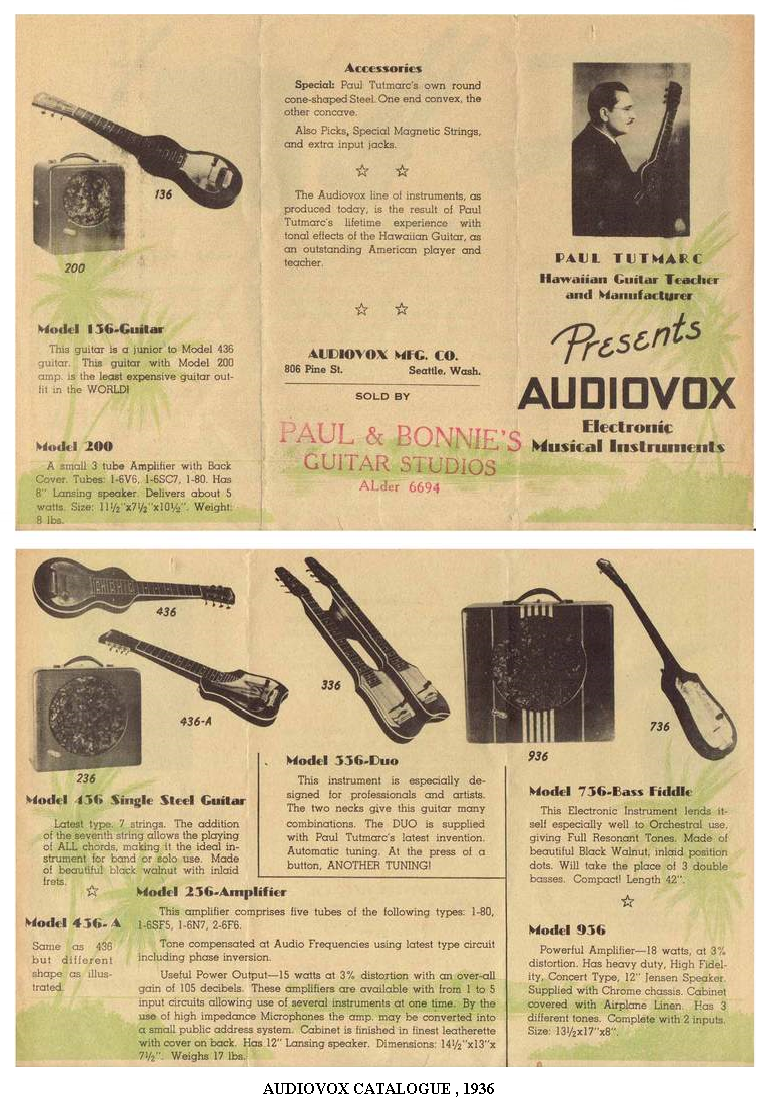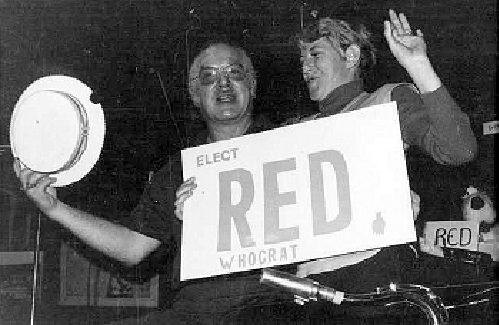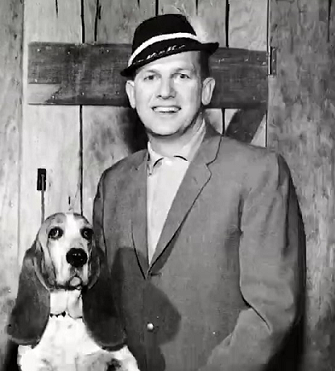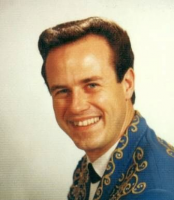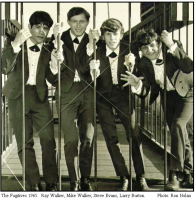
Over the decades there have been many bands throughout the U.S. or anywhere else in the English-speaking world calling themselves The Fugitives. The popularity-at least in the U.S.- probably goes back to the television action series, The Fugitive, that aired on the ABC network from September 1963 to August 1967. The premise of the series is that its protagonist, Dr. Richard Kimble (played by David Janssen) is a physician who has wrongly been convicted of his wife’s murder. En route to his final sentence, the death penalty, the train (the train?!!) he is riding on de-rails. He escapes and all sorts of adventurous plots ensue around Dr. Kimble searching out and playing a cat-and-mouse- game with the real killer; a one-armed man played by Bill Raisch. The one-armed man is mostly unseen but shows up in a few episodes. All the while Dr. Kimble risks revealing his identity and freedom as he does good deeds everywhere he goes. He even occasionally shows up saving the life of Lt. Philip Gerard (played by Barry Morse), the lawman who doggedly pursues him. The Fugitive has once more become a staple of cable TV.
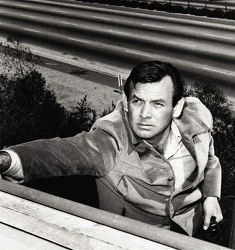
The Fugitive-Dr. Richard Kimble
As someone who has not seen the movie based on the television series I have no idea if the film follows the same conceit, but I’m almost certain it’s not as fascinating to a seven to ten-year-old kid like me who would try just about anything in the book to stay up Tuesday nights to see the show that didn’t air until 10:00 PM. This really was must-see TV…a Quinn Martin Production in glorious, full-spectrum black and white…until color came along.
The mid-60s group The Fugitives from Portland OR may not have become as prominent as others, but they do have the distinction of having the band’s name on their first and only single misspelled as “The Fugatives”. The record pressing plant misprinted the name and obviously, no one connected with the band did a press check. Although it was mislabeled on the record, Portland kids already knew who they were, and probably didn’t even notice the mistake. Another distinction is that the band took out a regional copyright for the name The Fugitives; an unusual move at the time, but it stopped other NW bands from using the name. However, the copyright didn’t extend into Canada, where over half a dozen bands named The Fugitives were found, during the 1960s in Lower British Columbia alone….and the regional copyright the band took out expired many years ago. Even in the 21st century, The Fugitives is still a fairly popular band name.
The Fugitives were popular on the Portland music scene from early 1965 until late 1967 and it seemed they were on their way to national prominence. Today they are barely a footnote alongside the great bands that are associated with Portland during the ’60s, the most famous being The Kingsmen and Paul Revere and The Raiders. The Fugitives were and are every bit as good as any garage band working in the Pacific Northwest at the time, but life doesn’t always work the way we wish it would. Not all the stars are aligned at the exact moment that our destiny’s fortune depends upon. Life gets in the way of most young people’s dreams…but the dreams can be fantastic if they are fulfilled for even a short year or two.
While the center of the early ’60s Northwest Sound hovered above Tacoma and Seattle, Portland was pumping out their own share of great teen dance bands. The R&B and garage rock elements were there, but they seemed to hang on a bit longer in Portland than many other Northwest music scenes. Portland bands were also a bit slower to branch out into the mid-’60s folk-rock and psychedelic blues sounds than Seattle and Tacoma; this was not a bad thing.
More eyes were on Seattle and Tacoma, but Portland and Eugene were also overflowing with talent. There were plenty of venues to play from Portland’s Crystal Ballroom and The Chase and The Headless Horseman to Pacific City’s beachside ballroom The Dunes and The Tork Club in Eugene. There was a string of armories, fraternal halls, nightclubs, high school gymnasiums and all-ages ballrooms that ran from Washington/Canadian border to at least Eugene. The fans were there to support local and touring bands. The major pitfall was that while Portland and Eugene had an extraordinary amount of talented bands and dedicated fans, travel was slow. There was the same a string of armories, fraternal halls, high school gymnasiums, and dance clubs up and down along what was US Route 99 until 1964 when the main route became the new interstate freeway. I-5.
The new freeway ran from the US-Mexico border to the US-Canada border where it connected to a direct route to Vancouver BC. Both I-5 and US Route 99 allowed bands to tour (by vehicle) up and down the west coast but there didn’t seem to be much reason for small northwest regional bands and their teenager fans to travel further south than Eugene OR. Driving to Eugene was a long-haul even by I-5 and when the main artery was US 99 the road did not bypass city centers. A drive from Seattle or Portland down the coast to Los Angeles could take days. Even the trip from Portland to the Oregon Coast could take hours upon hours. Most regional bands-especially garage bands-did did not travel by plane back then. Beyond Eugene, gigs were few and far between until the San Francisco Bay area and a few dance halls that dotted California’s Central Valley…places like Fresno, Stockton, Modesto and of course waaaay further south, the home of a new brand of country music, Bakersfield.
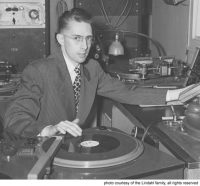
Robert Lindahl at his Northwestern Inc. Motion Picture and Recording Studios
As the 40s, 50s ’60s rolled in there were a handful of capable sound engineers that began to come to the fore; legends like Portland’s Robert “Bob” M. Lindahl who had been deferred with a medical waiver from service during WWII. Instead of military service, he began a career that lasted more than four decades as Portland’s top sound engineer. He bought out John Keating’s Portland studio (Keating had another in Seattle) and re-named it Northwestern Inc., Motion Picture and Recording Studios. It was one of the most sophisticated recording facilities on the west coast and future stars like Johnny Ray and Jimmie Rogers cut their breakthrough hits there…The Little White Cloud That Cried and Honeycomb, respectively.
It wasn’t until 1957 that Seattle’s J. F. “Joe” Boles built a basement studio in his new home (at 3550 Admiral Way) and began making Seattle recording history. A hobbyist since about 1951, Boles had a good ear and deft expertise with his Ampex recorders These traits brought him early clients like Seattle’s lounge singer, Pat Suzuki, and folk masters The Brothers Four. Boles was also responsible in part for The Fleetwoods phenomenal success with the national number one hit, ‘Come Softly To Me’ and the follow-up ‘Mr. Blue’ released as the first single on ‘Bonnie Guitar’ Buckingham and Bob Reisdorf’s Dolphin Records in 1959 (The label’s name was changed to Dolton in 1960). Boles, along with his cross-town compatriot, Kearney Barton, the owner of Northwest Recorders and later Audio Recorders Inc. managed to record, produce or engineer just about every important northwest artist of the day. The Frantics, The Wailers, Little Bill and The Bluenotes, The Ventures, The Sonics, The Kingsmen, Dave Lewis, The Dynamics, and Merilee Rush; the list barely scratches the surface.
Aside from a handful of other less modest successes, Seattle and Tacoma put out regional hit after regional hit, but it was two Portland bands of the day that set the template for national success. In retrospect we can see the tremendous contributions to rock that Tacoma’s The Fabulous Wailers or The Sonics have made; but their initial releases usually stalled somewhat high in the national charts, if even that far. It was Portland’s The Kingsmen and Paul Revere and the Raiders (with their roots in Caldwell Idaho) who made the biggest commercial splash.
Both bands recorded renditions of the song ‘Louie Louie’ that led them to the national spotlight, even though Rockin’ Robin (actually The Wailers) and Little Bill had done earlier versions. By the time The Raiders recorded ‘Louie Louie’ they had already seen interest from Columbia Records on the strength of an earlier, instrumental, boogie-woogie influenced release on Gardena Records called ‘Like, Long Hair’. ‘Like, Long Hair’ reached number 38 on the Billboard Charts. Although the initial pressing of Paul Revere and The Raiders’ version of Louie Louie first appeared on the Sandé label, the band was signed to Columbia right away and their version of ‘Louie Louie’ was released on Columbia Records.
The Kingsmen’s version of ‘Louie Louie’ had originally been released in a pressing of 1000 copies on Seattle’s Jerden Records. The band members were pretty much left to their own devices, selling copies to friends, members of their audiences and hawking them to club and radio disc jockeys. The Kingsmen version languished behind the Paul Revere and The Raiders version for several months before success came via Boston radio DJ Arnie “Woo-Woo” Ginsburg. It was his nightly exposure of The Kingsmen’s version-ironically voted nightly for weeks as the day’s ‘worst song’, while it was actually the day’s most requested. Fans of the song continued to vote it the ‘worst’ just to hear it nightly.
Wand Records, run out of New York City, was a subsidiary of the very successful Scepter label and had the power to make The Kingsmen’s version a number one hit that far outsold the Raiders version. Paul Revere and The Raiders went on to produce a string of hits during the 1960s (Kicks, Hungry, Indian Reservation, etc.) and garnered a regular TV spot on Dick Clark’s week-day ‘Where The Action Is’ program in 1965 and 1966. The Kingsmen never again dented the national charts the way they had with ‘Louie Louie’ but their definitive version of the song has outperformed all of the songs of Paul Revere and The Raiders…and that’s saying a lot since The Raiders put out some pretty good garage and pop singles.
The local Portland dance music scene had already been popular in the very early 60s but it practically exploded after the success of The Kingsmen and Paul Revere and The Raiders. Musicians in Portland, Eugene, Corvallis, Salem and other towns and cities around Oregon realized how potent the music coming out of the state could be. It’s said that by 1965 there were roughly 300 working bands in the Portland area alone. Hundreds-perhaps thousands- of bands arose around Oregon, as well as long-ignored southwest Washington because of this virtual youthquake. The Redcoats, The Moguls, The Gamblers, The Montells, and hundreds more kept the teen dance circuit well-fed. Some found local fame, others found regional success, some individuals went on to careers as sidemen, but most bands simply faded away as their members began to marry, have kids, and move on to careers that actually made money. Of course, the draft and the war in Viet Nam caused many young bands to dissolve…a threat that simply does not hang over the heads of young people today. Whatever the reason, there were many ‘could have beens’ if it weren’t for the randomness of history. The Fugitives are one of those ‘could have beens’...and in fact, they reached ‘were’ or ‘are’ for a short time.

PEPSI ENDORSEMENT
Rhonda Anderson,, Ray Walker, Larry Burton, Mike Walker. Steve Evans, Bob Bentz,, Ann Scott-Jenkins
The Fugitives was founded by brothers Mike and Ray Walker during their days at Portland’s Jefferson High School. Mike, the oldest, born on September 25th, 1948 was almost exactly one year older than Ray who was born on Sept 22nd, 1949. Perhaps the nearness of their age and having birthdays so close together were two of the reasons the brothers became so close as teenagers. Both had picked up the guitar during their early teens and both had started songwriting together and separately almost from the beginning. They honed their guitar skills off one another and played in local C&W bands for a few years. Finally, they decided to start their own band and get out there and play. Ray became the lead vocalist and lead guitarist. Mike also did some of the vocals and played rhythm guitar. Former schoolmate Steve Evans was recruited to play bass and drummer Larry Burton, who’s father had been an in-demand big-band drummer came in playing sticks. They began to practice covers of current hits, but mostly focused on their own songs. By the time three months had passed, they did their first professional gig. The Fugitives had arrived.
Their success on the Portland and the nearby Cannon Beach and Seaside OR teen dance circuit came quickly. One fan wrote;
“Band members can play anything from 4-4, hard rock to western and jazz, to formal dances. They prefer ballad rock. They have written much of their own material”
The Fugitives may have been adept at all the above genres and more, but it’s clear they were flat-out best at rock and roll and what we now call garage-rock. Like most of the other bands of the day, they had also been heavily influenced by the Beatles, and the British Invasion. The Fugitives were especially influenced by The Kinks and early Small Faces, but they also relied on the typical northwest -based sound. In fact, soon after forming they brought in organist and saxophonist Bob Bentz. R&B-based organ and raunchy sax were essential to many young northwest bands in the 50s and the early to mid-60s, and the formula popped up all across the nation.
By the time The Fugitives started finding local success they met John Hillsbury, who offered to manage them. Hillsbury was a prominent figure in Portland’s arts and theater community. His association with acting went back to the days of WWII when he began entertaining with the USO. After leaving the military Hillsbury landed in New York City, where he crafted his trade and became an accomplished actor, director and costume designer. He returned to Portland in 1957 and joined the film department of a local television studio, KPTV, even though he spent most of his spare time as an actor and somewhat of an impresario.

The Fugitives with Ann and Rhonda. Manager John Hillsbury in front.
“He was a wonderful actor,” according to Peggy West, a longtime friend, and fellow performer. “He had a wonderful background in New York City, but he also did a lot of theater in Portland”. Hillsbury was the founder and president of The Portland Playhouse, which opened in 1962 in the ballroom of the old Beaver Hotel on Northwest Glisan Street. According to West. “The Portland Playhouse’ put on some very good shows” she added. “He also did a lot of acting and directing for the Portland Civic Theatre.” Later Hillsbury founded Theatre A la Carte, a troupe that toured the northwest as a dinner theater. During the last decade of his life, John Hillsbury served as a clerk at the Arlington Club, a very exclusive gentlemen’s club that didn’t allow women as members until 1991. It was the kind of stuffy atmosphere one used to conjure up in the mind when the phrase ‘gentlemen’s club’ comes up. It was before the phrase evoked exotic dancers and a front for prostitution, but where important pillars of the community could hide-out from their wives, drink to excess, smoke cigars and fall asleep in huge chairs while reading the daily newspaper.
Hillsbury was also a Portland institution for his playing Santa Claus his grandniece Tracy Duerst of Silverton pointed out after his death from bladder cancer in 1998. “It was at Meier & Frank’s, the top department store in Portland where Hillsbury played Santa from the early 1970s to the 1990s, that he touched the most lives,” Duerst said.
John Hillsbury’s arts and civic connections, along with sheer hard work on the part of the band was a good mix. Hillsbury was an astute showman himself and he took every advantage he could to book or The Fugitives on the bills of Battles of The Bands across the northwest, important opening slots as well as sending the band up and down the West Coast and Canada. He also kept the band in the public eye through endorsements, whether they be local radio stations, the local Pepsi Cola bottler or appearances on local television and radio. For one brief year or two, The Fugitives were the most well-known band in the Portland area.
In 1965 Ray Walker had composed a song, ‘We Gotta Run’ as a proposed theme for a Portland-area television show. The show failed to materialize, but eventually, the band pressed up copies of We Gotta Run b/w ‘Don’t Pretend, a ballad written by Mike Walker. They released it on their own label-Trophy Records. The single (especially ‘We Gotta Run’) got attention from regional radio, especially on Portland’s KISN and KGAR, just across the Columbia River in Vancouver WA. Even though the pressing plant had misspelled the band’s name as ‘The Fugatives’ listeners. deejays and buyers hardly raised an eyebrow.

The Fugitives, 1966.
Clockwise from bottom Larry Burton, Ray Walker, Mike Walker, Annie Scott-Jenkins, Steve Evans, Rhonda Anderson. Bob Bentz would join the band after this photo was taken.
Ann Scott-Jenkins and Rhonda Anderson joined The Fugitives as dancers in June of 1966. Fans distinguished the two as “The Brunette” Rhonda Anderson, and Ann Scott-Jenkins as “The Blonde Bombshell”. In the summer of 1967, Ann and Rhonda were regulars on Portland local television station KOIN-TV’s ‘Battle of the Beat, a rock-music talent contest telecast on Channel 6. It only furthered their and The Fugitives exposure. After Ann and Rhonda joined The Fugitives they were considered full-time members of the band. The idea was to add a bit more spectacle to the live shows with costume changes and choreographed synchronized go-go dancing. The band members themselves switched between their kitschy jailhouse/convict stripes and some very sharp, well-tailored anglo-styled suits. Crude lighting and staging (by today’s standards) were provided by Dann Egan. Everything may not have been as slick as rock audiences expect today, but at the time it was miles ahead of other bands. It was around the same time Bob Bentz, the organist and sax player was brought on board, rounding out what would be the classic line-up of the live band.
Annie and Rhonda meeting up with The Fugitives was almost a Hollywood fantasy….in fact, Hollywood, in its own way did play a part.
The actress Jane Russell (Gentlemen Prefer Blondes, The Outlaw, etc.) was in Portland doing a series of charity shows for her WAIF (World Adoption International Fund) organization at the city’s glamorous art-deco Hoyt Hotel. Russell had founded WAIF in 1955. Jane herself was the adoptive mother of three children and worked tirelessly during the 1950s ’60s, ’70s and beyond to help Americans adopt unwanted children from overseas. She and WAIF were instrumental in the passage of laws that made it easier and more efficient for potential American parents to adopt unwanted children whose governments, astoundingly, would not allow them to be removed from the country of their birth. She was an all-around advocate of adoption and spent many years as a tireless proponent.
In 1981 Russell told the Washington Post:
“In the past several years, state and federal governments have been spending $800 million on foster care. We’ve got a bill that would do the same job for $163 million. How? By getting kids into adoptive homes. A lot of the kids are handicapped, and for years social workers have been keeping them in the closet. Take them out, and people fall in love with them.”
The Hoyt Hotel, built in 1912, was one of Portland’s architectural landmarks and sat directly across from the city’s Romanesque Revival Union Station. The Hotel later had the reputation of a “fleabag hotel”, but in 1962 the former “fleabag” had a very expensive, luxurious renovation, courtesy of Harvey Dick, who had owned the building since 1941. Two lounges were added- The Barbary Coast and The Roaring 20s Room. Suddenly The Hoyt was the place to be seen and attracted both the city’s social set and out-of-town celebrities like Anne Francis, Johnny Carson, Duke Ellington, and of course, Jane Russell.

THE FUGITIVES at Portland’s Oriental Theater, November 1966.
It was no surprise that Russell, as producer, chose the glamorous Hoyt Hotel to hold her charity shows, that she called ‘Cabaret Goo Goo’ Jane had requested a “Beatles-type” band to fill a slot in her nightly show. ‘The Fugitives’ were chosen to play. Before long they were doing two sets a night for ‘Cabaret Goo Goo’ and soon were put into the feature spot of the show. One night after Jane Russell became aware of two aspiring dancers, Ann Scott and Rhonda Anderson, were in the house, she urged them to join the band onstage for one set. In 2007 Ann wrote “Everyone loved it and the group became “The Fugitives with Ann & Rhonda”. We traveled throughout Oregon, Washington, California and British Columbia”… sometimes as ‘The Fugitives with The Jet Set Girls’.
During the stint with Jane Russell’s WAIF benefits the annual Rose Festival was in progress. Several years earlier the Rose Festival had started hosting an annual ‘Teen-Age Fair’. It’s estimated that in 1966 over 100,000 people attended the event which was held over 10 days. Each year the event culminated with a ‘Battle of The Bands’ at Portland’s Memorial Coliseum. Each of the 96 bands involved that year had gone through three preliminaries. ‘The Fugitives’ were one of those bands and ended up in the final three. On a night in June 1965, in front of 21,00 people The Fugitives played their set and were awarded as the overall winners.
The Fugitives were not a typical four or five-piece combo along with a couple of girl dancers. They were determined to put on a great visual show to please a variety of audiences. Actor/designer/manager John Hillsbury was largely responsible for helping them reach that goal. Despite being proficient at many genres it’s undeniable their stock in trade was rock. It’s also reported they were partial to ballads, most of them written by themselves. Their songwriting was a bit more sophisticated than most other garage bands, but a particular weakness was found in some of the ballads’ vocals. Their recording of the song ‘Don’t Pretend’ is slightly marred by vocals that are too nasal sounding, and there’s no doubt the performance could have been improved on had the recording not been a ‘one-take’ which was common in those days. As cheap as it seems today it was plenty of money for a bunch of teenagers to record. It’s rumored that the total studio bill for The Kingsmen’s recording of Louie Louie was $36…and band members had to pony up to pay since their manager brought no money with him.
The Fugitives’ lead guitar work by Ray Walker more than makes up for ‘any shortfalling on ‘Don’t Pretend’. His playing (mostly single note picking) may not match the players we’ve become used to, but for an early 60s regional band it was impressive. Ray was distinctly headed down the road of becoming an adept, fast and energetic picker. What was intended to be the B side of the single ‘We Gotta Run’ was far more lively and rooted in rock and roll. It inevitably became the more popular side. The song still sounds great as a regional example of regional garage-rock; lyrics that aren’t particularly deep, a great hook and above all, fun. Recorded in the days before gating, and compression the single-take recording is fun in itself, just to hear Ray stepping a couple of steps back momentarily from the microphone during an exciting section. That kind of glitch (which isn’t really noticeable unless I’d told you and you were paying attention} is exactly what garage rock is and was all about.
After winning regional success with a great single, tours up and down the west coast and hordes of fans it seemed that The Fugitives were about to make a huge breakthrough, following earlier Portland successes. There’s no doubt everything was in place. Mid-1966 had brought them a surprising amount of attention, and the attention carried over well into the summer and fall of 1967. “That’s when”, said one observer said, “they really hit their stride.” With all the hoopla that was surrounding them, the band signed a five-year contract with Eugene’s Tork Club Records. The band announced they had up to ten songs ready to record.
The label, Tork Club Records, was meant to be the centerpiece of a syndicate of 74,000 members of various fan clubs that would assist bands across the nation in bookings and recordings. The proposed syndicate was to be initially run from Eugene’s popular teen dancehall, The Tork Club; variously known as ‘The Torq’ or ‘The Torque’ all of which were shortened from the club’s original name, ‘The Torquilstone’. Fans of faux-medieval lore, Robin of Locksley or Robin Hood will recognize this as the name of the massive castle and home of the villainous Reginald Front-de-Boeuf that Sir Walter Scott writes about in his novel Ivanhoe.
The Tork Club project never really got off the ground, and no studio tapes by The Fugitives have been found. The Eugene Tork Club label seems to have shortened its name to Tork Records, and ended up releasing only one single….Round Randy b/w Another Day by Eugene garage rockers The Moguls. The single, by the way, is excellent.
Then, as quickly as they rose above other Portland bands, The Fugitives disappeared.
Late 1967 would be the turning point for The Fugitives. Mike Walker enlisted in the U.S. Army. He also married his first wife, Carlotta Stiger on December 23rd. The marriage was brief, and the couple divorced on March 5th, 1971. Not long after his marriage and enlistment, Mike was sent to Germany where he became a Military Police Officer. After his three year enlistment, he returned to Portland to attend Portland Community College, getting an Associate degree in Criminal Justice. He then moved to Seattle to attend the University of Washington. To help finance his studies Mike took a position with the U of W Campus Police and attended their in-house academy. In his spare time, he attended graduate school at Seattle University.
In 1975 Mike decided to become a Seattle Police Officer and attended the Seattle Police Department’s Police Academy. He tied for number one in his class.
After four years as a beat cop, Mike joined the SPD Vice Squad. He stayed four years before being assigned to the North Seattle precinct, where he met his second wife, with whom he had two children. That marriage also didn’t survive…nor did the next two. Finally, Mike married his fifth wife, Katherine. In 2004, after 32 years on the force, Mike had to retire for health reasons.
Ray Walker did not fare as well as his brother. He enlisted in the Army in January of 1968. Almost immediately he was sent to Viet Nam and found himself directly in the middle of the conflict. His brother Mike had called him “the patriotic sort” so it wasn’t surprising that he signed up for a second tour of duty in the combat zone. Unfortunately, Ray, like many other vets, returned to the United States cynical, broken, disillusioned, an outcast, and with a full-blown addiction to black tar heroin, which seemed to alleviate those problems…at least for a while. According to a family member, when Ray had fulfilled his service he wore his dress uniform on his flight from Viet Nam back to the United States. After the plane landed on the U.S. mainland he went to the nearest bathroom in the airport, took off his uniform and threw it into the garbage. He’d brought along civilian clothes to change into. What followed were years of addiction and uncertainty that led to complete estrangement from most of his family.
Ray drifted for several years and finally married Karen Silvis on October 3rd, 1980. The couple had two children, Raeline and Kris. Unfortunately, the marriage was also short-lived. The couple divorced in 1985. After Ray died of cancer in September 2004, his brother Mike gave the eulogy at his memorial. At his brother’s insistence, Ray had spent the last five months of his life being cared for by his brother and sister-in-law. In his eulogy, Mike extolled his younger brother’s virtues of loyalty, generosity, kindness and caring, but also added a comment on Ray’s unfulfilled life and his relationship with his ex-wife and his children.
“Sadly the barriers of life created too many obstacles for their young love to overcome,” Mike said of Ray and Karen. “Ray was unable to fulfill his obligation as a husband and father and was tormented continually thereafter by that reality” In a bittersweet moment Mike added “Days before his death Ray happily reunited with his children whom by their sincere expressions of love and understanding brought him peace and contentment to the emptiness he had previously felt deep within his heart”
After their marriage, Mike and Kathleen had moved to a ranch in Arlington WA. He and Kathleen remained married for 22 years while he lived out his life helping friends with home projects, getting involved in animal rescue and building a 3,000 square foot log home. He died of cancer on his 67th birthday, September 25, 2015
Ann Scott (who now prefers to be called ‘Annie’) says that she lost track of the group after moving to Los Angeles in 1969. She continued with her dance career and went on to become one of the members of Dean Martin’s Las Vegas-style backup dancers and singers The Golddiggers. The popular Dean Martin Show ran from 1965 to 1974 on the NBC network. Aside from working with Martin on television, ‘The Golddiggers’ performed alongside him at nightclubs and toured with Bob Hope on his worldwide USO tours. The ‘Golddiggers’ even cut three of their own albums. The first two, on the Metromedia label, were ‘The Golddiggers’ in 1969, and later that year ‘The Golddiggers; We Need a Little Christmas’. In 1971 RCA released their third album ‘The Golddiggers…Today’.
Annie, who now lives near Seattle, tells me she also hyphenates her last name to Scott-Jenkins, using both her maiden and her married names so old friends and the professionals she’s worked with over the years had an easier time finding her.
“After leaving Portland I was in Los Angeles for a number of years, dancing, and then our show had a hiatus…a Christmas vacation kind of thing I went to San Francisco and stayed with a girlfriend for the holidays. I was on a cable car one night and a sailor jumped on and took my breath away, so I married him. He was from Texas, so we moved to Texas for a couple of years. He was working for some record companies back there and then they moved him out to Los Angeles. We had a daughter in May of ’74 and L.A. was getting too crowded. There was too much violence and smog. My parents lived in Seattle. They had moved from Portland to Seattle after I’d moved out, so we thought ‘Why don’t we move to Seattle? It’s a pretty nice place and we’ll be near grandparents who could be babysitters. ’ Our daughter was their only grandchild, so that’s how we got up here”.
Although Annie had lost all contact with the former Fugitives she did have a later encounter with one of them.

The Fugitives Hand-drawn poster for their 1967 Summer tour of Canada
“I was working in a bank in downtown Seattle in the mid-’80s. On a Monday morning our security man, who was an off-duty police officer, came in and said: “I was at a party Saturday night and I saw your picture on a poster”.
I thought “WHAT?!!”
He said “Do you know Mike Walker?” and I said, “I sure do!” Then the security officer told her “He’s got your picture hanging in his living room!”
“About a week later Mike came walking into the lobby of the bank.” Annie says, “I hugged him and asked ‘what do you know about the other guys?’ He didn’t know much and said that Ray had gone into the military, but he said they didn’t talk with each other very much”.
“Later, I knew that Steve Evans had passed away,” Annie tells me. “ A woman who had known him sent me some pictures of Steve later in life. I would never have recognized him. He was so tall and thin when I knew him”.
Annie adds “They were a bunch of great guys. They were always gentlemen. They treated me like a little sister and made sure I was okay and I was protected from the crowds”.
Annie lamented that while attending her 50th-year reunion last September at Portland’s Wilson High School she was saddened to hear how many of her classmates were gone. “It’s amazing how many passed away in the last 50 years,” she says, then adds “I was thinking of posting on my facebook page to find out what happened to (former Fugitives) Larry Burton and Bob Bentz’. Annie followed through with her plan and almost immediately heard back from Bob Bent. who now uses his real first name, Robert. Annie herself sounds fit when I speak with her on the phone, though she tells me “I had hip-replacement surgery last May, so my dancing has caught up with me. My body’s fighting back now!” she says with a laugh
Ann and Rhonda both took part in the beauty pageants that were so prevalent in the 1960s and 1970s. Rhonda was originally from Long Beach CA and had already won a Miss Teen Talent contest by the time she connected with The Fugitives. In 1967 Ann was crowned Miss Teenage Portland and then went on the National Miss Teenage America Pageant held in Dallas later that year. She came in third. “We both were in talent shows,” Annie says of her and Rhonda Anderson. “Rhonda went on to become Rose Festival Queen in 1969 and was crowned Miss Portland in 1971”.
Rhonda attended Lewis and Clark College, studying psychology and began developing an interest in mime. Later she toured Europe with three other performers in the prestigious Oregon Mime Troupe. After returning to the U. S. she moved to Chicago and said she also lost touch with her fellow bandmates. Rhonda went into the commercial real estate business and did well for 20 years. Beginning in the early 1990s Rhonda started to develop the signs of Multiple Sclerosis, and ultimately became physically unable to keep up with her career in real estate. She returned to Portland and lived out her life until passing away on March 26, 2007.
Steve Evans continued his musical career in and around Portland. He played bass guitar, bongo, trumpet, trombone and occasionally sang with various bands around town. Eventually, he became a member of the popular act ‘The Action Unlimited Show Band’ The combo became the house band at Portland’s long-gone establishment The Longhorn (no relation to the current national chain). After The Longhorn closed (and was later demolished), the band was a regular feature for several years at Taylor’s Viewpoint during its time as a bar and dance club. In the mid-’80s Steve married and had two children, Chad and Emily. He went into retail and became a long-time employee of the Mervyns store in Portland’s Gateway Shopping Center. Steve died at home from cancer on March 9, 2012.
Sadly, The Hoyt Hotel and it’s Barbary Coast nightclub and Roaring 20s Room closed in 1972 due to lack of business. The hotel itself was demolished in 1977. The entire block on which the hotel stood has been unoccupied since 1988. It is now a pile of rubble in severe need of toxic clean-up. According to the Oregon Department of Environmental Quality:
“The site has been vacant since 1988. Portions of the site were developed as early as 1889 (blacksmith, paint shop). At least three dry-cleaning sites and two service stations were present at the site from as early as the mid-1920s to the 1960s. Hotel Victoria (1931-1960) and the Hoyt Hotel (1911-1977) also operated at the site. A Pacific Trailways bus depot operated on-site between 1980-1985. Underground storage tanks were expected to be associated with the service stations and possibly the hotels. PDC acquired the property from Hood Stages Inc., doing business as Trailways, Inc. in October 1977.”
The report goes on to say “A risk screening indicated that arsenic and a number of PAHs in soil, and arsenic, lead, and benzo(a)pyrene in groundwater, are contaminants of potential concern.”
It’s hard to say if and when this prime parcel of historic downtown Portland will be cleaned up and developed.
As of this writing, it’s unknown to me what Larry Burton did after the dissolving of The Fugitives. One can only hope he’s still alive, happy, healthy and prosperous. If you have any information regarding him, please leave a message in the comments section below. Like all the others associated with The Fugitives, it’s hoped his time in the band enriched his life. Despite mysteriously never reaching the heights they could have achieved, they are, individually and collectively the typical, yet extraordinary products of all young persons’ desire to find fame even though very few make it to the top.
As we know, Portland eventually joined the ranks of Seattle, Tacoma, Athens GA, Austin TX and other mid-sized cities throughout the US as meccas for commercial and underground music. This time around the success and respect would be wider and more profound than the ’60s. There had been massive success for The Kingsmen and Paul Revere and The Raiders and modest regional success for others in Oregon’s early ’60s, but for the most part the garage rockers of the day returned to what we may think are mundane lives (they are not). As the decades rolled on bands like The Wipers, Dead Moon, Everclear, Blitzen Trapper, Poison Idea, The Dandy Warhols, Hazy, Chris Newman and dozens of others have attained national critical and/or commercial success.
Somewhere out there, whether it’s in Lincoln Nebraska, Portsmouth, New Hampshire, or some other out-of-the-way suburb there are a bunch of kids banging out music that could make them the best band in the country…maybe the best band in the world. They may never be heard by anyone but a handful of their friends. There’s a very small chance they’ll rise to the top…as I’ve said, so many stars must be aligned, but more likely they will find a fair bit of attention for a short while and then get on with life as we know it. This is the legacy of The Fugitives and thousands of other bands in garages and basements everywhere. The truth is that ‘could have been’ is far more satisfying than ‘never was’.
-Author; Dennis R. White. All images courtesy of Debbi Mullins except where noted. The Fugitive photo: Courtesy Quinn-Martin Productions. Deborah Kay Mullins ‘Interviews and Notes on Family History’ ( December 14, 16, 20, 2018) Tom Vogt ‘Paul Revere’s Vancouver-based Manager Pays Tribute’ (The Columbian, October 9, 2014). Ann Scott-Jenkins ‘The Fugitives’ (PNW Bands. May 2007). Sharie Gallup ‘The Fugitives’ (PNW Bands, July 2012). Stephen Haag ‘ Arnie ‘Woo Woo Ginsburg’ (November 11, 2003 ). Randy Hill ‘Louie Louie: The Rest of The Story’(Pamplin Media, November 11, 2003). Deb McManman ‘Flashback To The Nostalgic 60s; a Fond Reminiscence of Innocence and Rock and Roll (lanemusichistory.com, retrieved December 18. 2018). Jim Scheppke ‘The Kingsmen’ (The Oregon Encyclopedia; A Project of Portland State University and The Oregon Historical Society, March 17, 2018). ‘Last Ring. Mike M. Walker #3987′ (Retired Seattle Police Officers’ Association, 2015, retrieved December 26, 2018). Author Unknown ‘Band of The Month: The Fugitives with Ann and Rhonda'(Date Unknown). Ruth Ryon ‘Her Kind of House; Actress Jane Russell’s rich, varied life is reflected in her Santa Barbara estate’ (Los Angeles Times, October 10, 1999). Christian Williams ‘Jane Russell’s WAIFs &’ (The Washington Post, March 12, 1981). Michael Walker ‘Eulogy For Raymond Walker’ (Sep 9, 2004, Kelso WA). Obituary, ‘Anderson, Rhonda Marie 1951-2007’ (The Portland Oregonian, April 8, 2007). ‘Obituary, Raymond Wayne Walker’ (The Longview Daily News, September 24, 2004). Peter Blecha ‘Recording Studios of the Pacific Northwest (1940s-1960s)’ July 26, 2009 (HistoryLink.org, essay 8946). Author Unknown ‘New Club to Cater to Young Clientele’ The Eugene Register-Guard, April 5. 1965). Niki McDonough, ‘Interview and conversation’ (January 8, 2019). John Chilson ‘The Barbary Coast at The Hoyt Hotel’ (Lost Oregon, September 9, 2008). State of Oregon: Department of Environmental Quality ‘Environmental Cleanup Site Information (ECSI) Database Site Summary Report – Details for Site ID 3103, PDC Block R’ (January 17, 2019). Annie Scott-Jenkins ‘interview’ (January 14, 2019). Author unknown ‘N & W’s Jack Burton, Son Larry Spark Top Rock ‘n Rollers’ (Traffic Manager Magazine [Portland OR] November 1966). Obituary, Steve Edward (JC) Evans’ (The Oregonian [Portland OR] Mar. 18, 2012). Special Thanks to Sharie Gallup, Nikki McDonaugh, Debbi Mullins and Anne Scott-Jenkins






